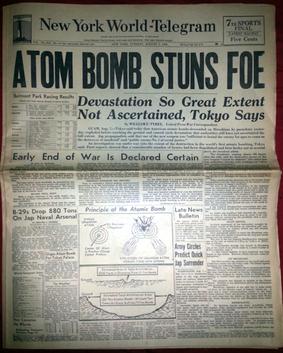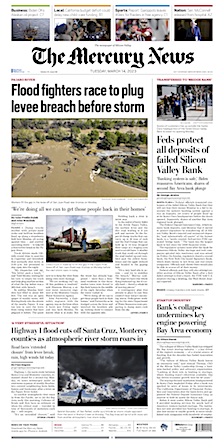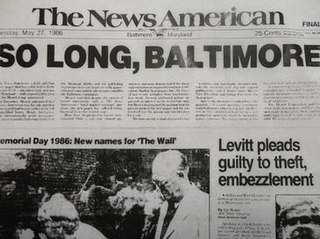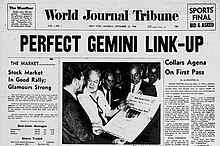Closing
The World Journal Tribune never became economically viable, and it ceased publication eight months later, on May 5, 1967. [4] During its short life, the paper never opened a Washington bureau, and did not have any foreign correspondents on its staff, [2] relying instead on the Los Angeles Times–Washington Post News Service for foreign coverage. [1]
The folding of the WJT left The New York Times , the New York Daily News , and the New York Post as the only daily English-language general circulation newspapers in New York City for many years, when in 1900 there had been fifteen. [5] [6]
One survivor of the demise of the World Journal Tribune was New York magazine, which began as the Sunday supplement for the Herald Tribune and continued after the merger as the supplement for the WJT. After the newspaper folded, the editor of New York, Clay Felker, bought the rights to the title with partners and brought it out as a glossy magazine. [7]

The Boston Herald is an American daily newspaper whose primary market is Boston, Massachusetts, and its surrounding area. It was founded in 1846 and is one of the oldest daily newspapers in the United States. It has been awarded eight Pulitzer Prizes in its history, including four for editorial writing and three for photography before it was converted to tabloid format in 1981. The Herald was named one of the "10 Newspapers That 'Do It Right'" in 2012 by Editor & Publisher.

Hearst Communications, Inc., often referred to simply as Hearst, is an American multinational mass media and business information conglomerate based in Hearst Tower in Midtown Manhattan in New York City.
Yellow journalism and yellow press are American terms for journalism and associated newspapers that present little or no legitimate, well-researched news while instead using eye-catching headlines for increased sales. Techniques may include exaggerations of news events, scandal-mongering, or sensationalism. By extension, the term yellow journalism is used today as a pejorative to decry any journalism that treats news in an unprofessional or unethical fashion.
The Chicago American was an afternoon newspaper published in Chicago, under various names until its dissolution in 1975.

The New York World-Telegram, later known as the New York World-Telegram and The Sun, was a New York City newspaper from 1931 to 1966.

The New York Herald was a large-distribution newspaper based in New York City that existed between 1835 and 1924. At that point it was acquired by its smaller rival the New-York Tribune to form the New York Herald Tribune.

The New York Herald Tribune was a newspaper published between 1924 and 1966. It was created in 1924 when Ogden Mills Reid of the New-York Tribune acquired the New York Herald. It was regarded as a "writer's newspaper" and competed with The New York Times in the daily morning market. The paper won twelve Pulitzer Prizes during its lifetime.

The Mercury News is a morning daily newspaper published in San Jose, California, in the San Francisco Bay Area. It is published by the Bay Area News Group, a subsidiary of Digital First Media. As of March 2013, it was the fifth largest daily newspaper in the United States, with a daily circulation of 611,194. As of 2018, the paper has a circulation of 324,500 daily and 415,200 on Sundays. As of 2021, this further declined. The Bay Area News Group no longer reports its circulation, but rather "readership". For 2021, they reported a "readership" of 312,700 adults daily.

The New York World was a newspaper published in New York City from 1860 until 1931. The paper played a major role in the history of American newspapers. It was a leading national voice of the Democratic Party. From 1883 to 1911 under publisher Joseph Pulitzer, it was a pioneer in yellow journalism, capturing readers' attention with sensation, sports, sex and scandal and pushing its daily circulation to the one-million mark. It was sold in 1931 and merged into the New York World-Telegram.

The Overmyer Network, later the United Network, was a short lived television network. It was intended to be a fourth national commercial network in the United States, competing with the Big Three television networks. The network was founded by self-made millionaire Daniel H. Overmyer, who started WDHO-TV, in his birthplace, Toledo, Ohio, which had signed on the air on May 3, 1966. Overmyer had construction permits for several other UHF stations that were intended to be owned-and-operated stations of the new network. Before going on the air, the majority interest in those stations was sold to AVC Corporation in March 1967. A social conservative, Overmyer had decided to create a nationwide hookup, enticing existing stations with a 50-50 profit split with potential affiliates. Under the leadership of former ABC television president Oliver Treyz, the ON was scheduled to debut in the fall of 1967 with anywhere from 75 to 125 affiliates with an 8 hour broadcasting day.
The Syracuse Herald-Journal (1925–2001) was an evening newspaper in Syracuse, New York, United States, with roots going back to 1839 when it was named the Western State Journal. The final issue — volume 124, number 37,500 — was published on September 29, 2001. The newspaper's name came from the merger of the Syracuse Herald and the Syracuse Journal.

The New York Journal-American was a daily newspaper published in New York City from 1937 to 1966. The Journal-American was the product of a merger between two New York newspapers owned by William Randolph Hearst: The New York American, a morning paper, and the New York Evening Journal, an afternoon paper. Both were published by Hearst from 1895 to 1937. The American and Evening Journal merged in 1937.

The Sun was a New York newspaper published from 1833 until 1950. It was considered a serious paper, like the city's two more successful broadsheets, The New York Times and the New York Herald Tribune. The Sun was the first successful penny daily newspaper in the United States and the first one to hire a Police reporter. It was also, for a time, the most successful newspaper in America.
The Newspaper Preservation Act of 1970 was an Act of the United States Congress, signed by President Richard Nixon, authorizing the formation of joint operating agreements among competing newspaper operations within the same media market area. It exempted newspapers from certain provisions of antitrust laws. Its drafters argued that this would allow the survival of multiple daily newspapers in a given urban market where circulation was declining. This exemption stemmed from the observation that the alternative is usually for at least one of the newspapers, generally the one published in the evening, to cease operations altogether.

The New York Daily Mirror was an American morning tabloid newspaper first published on June 24, 1924, in New York City by the William Randolph Hearst organization as a contrast to their mainstream broadsheets, the Evening Journal and New York American, later consolidated into the New York Journal American. It was created to compete with the New York Daily News which was then a sensationalist tabloid and the most widely circulated newspaper in the United States. Hearst preferred the broadsheet format and sold the Mirror to an associate in 1928, only to buy it back in 1932.

The Baltimore News-American was a broadsheet newspaper published in downtown Baltimore, Maryland until May 27, 1986. It had a continuous lineage of more than 200 years. For much of the mid-20th century, it had the largest circulation in the city.

The Washington Times-Herald (1939–1954) was an American daily newspaper published in Washington, D.C. It was created by Eleanor "Cissy" Patterson of the Medill–McCormick–Patterson family when she bought The Washington Times and The Washington Herald from the syndicate newspaper publisher William Randolph Hearst (1863–1951), and merged them. The result was a "24-hour" newspaper, with 10 editions per day, from morning to evening.

Frank Andrew Munsey was an American newspaper and magazine publisher and author. He was born in Mercer, Maine, but spent most of his life in New York City. The village of Munsey Park, New York is named for him, along with the Munsey Building in downtown Baltimore, Maryland at the southeast corner of North Calvert Street and East Fayette Street.

The history of American newspapers begins in the early 18th century with the publication of the first colonial newspapers. American newspapers began as modest affairs—a sideline for printers. They became a political force in the campaign for American independence. Following independence the first amendment to U.S. Constitution guaranteed freedom of the press. The U.S. Postal Service Act of 1792 provided substantial subsidies: Newspapers were delivered up to 100 miles for a penny and beyond for 1.5 cents, when first class postage ranged from six cents to a quarter.
The Syracuse Telegram was established in 1922 in Syracuse, New York, by William Randolph Hearst. Between the years 1922–1925, the newspaper was published as both Syracuse Telegram and Syracuse Evening Telegram and the Sunday edition was called the Syracuse American, and alternately the Syracuse Sunday American.















